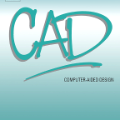Computer Aided Design (CAD) is widely used in the creation and optimization of various industrial systems and processes. Transforming a CAD geometry into a computational discretization that be used to solve PDEs requires care and a deep knowledge of the selected computational method. In this article, we present a novel integrated collocation scheme based on smart clouds. It allows us to transform a CAD geometry into a complete point collocation model, aware of the base geometry, with minimum effort. For this process, only the geometry of the domain, in the form of a STEP file, and the boundary conditions are needed. We also introduce an adaptive refinement process for the resultant smart cloud using an \textit{a posteriori} error indication. The scheme can be applied to any 2D or 3D geometry, to any PDE and can be applied to most point collocation approaches. We illustrate this with the meshfree Generalized Finite Difference (GFD) method applied to steady linear elasticity problems. We further show that each step of this process, from the initial discretization to the refinement strategy, is connected and is affected by the approach selected in the previous step, thus requiring an integrated scheme where the whole solution process should be considered at once.
翻译:计算机辅助设计(CAD) 被广泛用于各种工业系统和工艺的创建和优化。将 CAD 几何转换成用于解决 PDE 的计算分解,需要小心谨慎,需要深入了解选定的计算方法。在本篇文章中,我们提出了一个基于智能云的新型集成合用方案。它使我们能够将CAD 几何转换成完整的点对齐模式,了解基本几何,并作出最低限度的努力。对于这一过程,只需要以STEP 文件的形式对域进行几何,并需要边界条件。我们还采用一个对结果的智能云进行适应性改进的过程,使用\ textit{a posteriori} 错误指示。这个办法可以适用于任何2D或3D的几何方法,也可以适用于任何PDE,并适用于大多数点对齐合用办法。我们用一个网位自由的通用金融差异(GFD) 方法来帮助稳定线性弹性问题。我们进一步表明,从最初的离散战略到边界条件的每一个步骤,我们还要采用一个统一的步骤,一旦考虑,就会影响到一个完整的办法。




